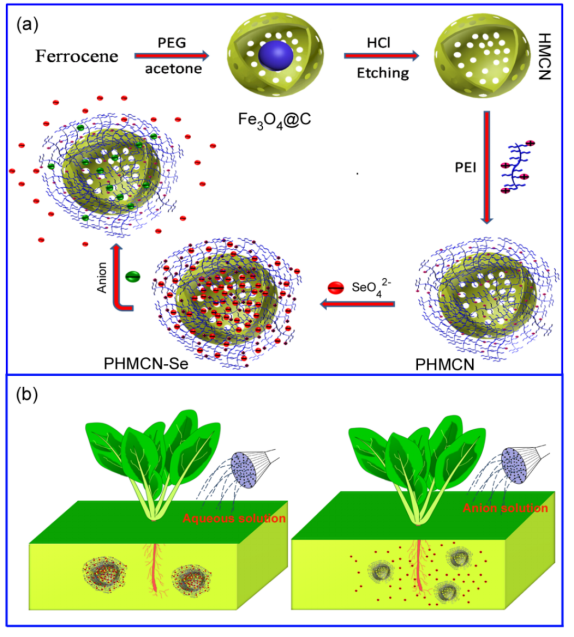
A study team led by Professor WU Zhengyan in Institute of Technical Biology and Agriculture Engineering, Hefei Institutes of Physical Science developed an anion-responsive nanosystem to control selenium fertilizer release by polyethylenimine modified hollow/mesoporous carbon nanoparticles.
The paper entitled "Anion-Responsive Carbon Nanosystem for Controlling Selenium Fertilizer Release and Improving Selenium Utilization Efficiency in Vegetables" was published in Carbon.
Selenium (Se) is an essential trace element to maintain the organism health of human beings and animals because of its anti-oxidative and anticancer ability. Se deficiency in humans could cause some serious diseases, such as cardiovascular disease, infertility, and even death.
Vegetable and cereal are primary sources of Se in diets, and contribute approximately 70% Se intake to body. The facile way is to improve Se content in crops via adding Se-enriched fertilizers into soil.
However, traditional Se fertilizer could be easily lost with rainwater, especially in acid soil, leading to low Se utilization efficiency. Moreover, the lost Se, mainly selenate and selenite which are both highly toxic, causing water pollution through leaching and run off. Therefore, it is urgent to develop new Se-enriched fertilizer to resolve these problems.
WU's team utilized a cationic polymer (PEI)-modified hollow/mesoporous carbon nanoparticle (PHMCN) to fabricate a novel slow release nanosystem which was then used to adjust the release of Se fertilizer via anion exchange.
This nanosystem shows a high loading capacity for selenate and excellent anion-responsive release behavior. Besides, this nanosystem effectively regulates the absorption of vegetable for selenate, making vegetable possess more Se.
Moreover, inorganic Se was successfully transformed into organic Se after absorption by plant, and the transformation efficiency was up to 93.2%. The yield of vegetable treated with PHMCN-Se could be significantly enhanced via the stimulation of anions.
Therefore, this smart nanosystem could be a promising candidate for enhancing Se utilization efficiency in vegetables and avoiding Se fertilizer loss in soil.
This research was supported by the National Natural Science Foundation of China, the Key Program of the Chinese Academy of Sciences, and the Youth Innovation Promotion Association of the Chinese Academy of Sciences.

Figure. (a) Schematic representation of the fabrication process of anion-responsive Se fertilizer CRS. (b) Schematic diagrams of CRS to regulate the release behavior of Se element in soil via anion stimulation. (Image by ZHANG Guilong)

86-10-68597521 (day)
86-10-68597289 (night)

86-10-68511095 (day)
86-10-68512458 (night)

cas_en@cas.cn

52 Sanlihe Rd., Xicheng District,
Beijing, China (100864)

